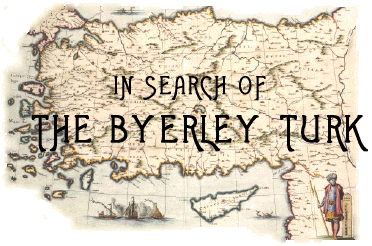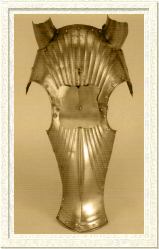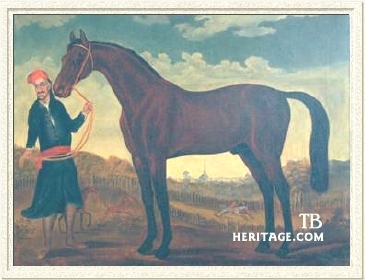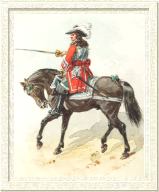|
|
In Search of the Byerley Turk

|
|

See also: Portrait of the Byerley Turk |
|
| |
Author Jeremy James travelled the United Kingdom and Ireland and the breadth of the near-east in search of the true story of the Byerley Turk. His new book, The Byerley Turk,written as a novel, reflects his detailed research into the facts behind the legend, and includes endnotes, appendices, a full bibliography, and black and white plates. Published in the USA by Stackpole Books at the end of September, 2005.
| |
|
Turkey is landscape of enigmas. Whereas the western coastline is littered in sarcophagi, amphitheatres, Doric and Ionic columns, the east is full of artifacts of less obvious origin. Hittite and Persian. And whereas you might find 10th Century Bagratid cathedrals in the mountains of Eastern Turkey, you will find the greatest cathedral in all Christendom in Istanbul -- or was, until Mehmed II took it, along with Constantinople in 1453, when the Crescent replaced the Cross. Mehmed became Sultan, Padishah, Khan, Ghazi, Sovereign of Two Lands and Two Seas, Margrave of the World and Caesar: the conquering Selçuks been astute enough to marry into the family of the Roman Emperors. To this day some academics claim that the Turks are the last expression of the Eastern Roman Empire. And these were Turks: they were not Arabs, they came from the east, not from the south. Their tongue was Turkik, their religion Islam. They wrote using Arabic characters but the language was Ottoman Turkish, not Arabic. It's a mistake commonly made, particularly when looking at miniature paintings of the period. Even authorities who ought to know better have assumed them to be of Persian or of Arabic origin. But they're not. They're Ottoman.
The Turks had come with the horseman archers on big fast horses, and not the little skimpy creatures the west portrays. The size and quality of the horses lies beyond doubt. And were these Arab horses. There was not a smidgin of Arab blood in their bodies -- the horses of the Turks, were Turks.
It took a long time to find that out, to ride through Turkey on horseback, to find antique, crumbling float-plate stirrups and strange bits, to handle remnants of saddles totally unknown in the west... to hear peculiar stories, listen to strange anecdotes, unravel ancient memories and find that once, many years ago, the landscape of Anatolia had been filled with horses. Beautiful, big, fast horses. It took time to trawl though the manuscripts in the libraries of Istanbul, to pull out material the west has never bothered to look into, to find out what these horses were, how they were bred, where they were schooled and by whom.
As I searched, I became more and more astonished to find that the west has gone along on such slender knowledge for centuries without ever looking where it had ought to have looked. Not once has it attempted, it seems, to find hard evidence of what exactly constituted the Turk horse that gave us the modern thoroughbred. I found many breeds long extinct -- Karaman, Germiyan, Ayvacik Midillian, Canik, Çukurova, Cilician, Kastamonu, Rumeli, Uzunyayla -- breeds of which the west has never heard, breeds that were commonplace to the Ottoman Turk. These horses were bred in vast hirashi (state studs) all over the Ottoman Empire, from the Levant to the borders of the Hapsburg Empire. They were bred, too, in timars -- feudal land holdings -- to superb quality, no horses on the face of the earth could match them. By the late 16th Century the Sultan could raise a cavalry of over 200,000 perfectly mounted horsemen without putting his hand in his pocket.
Turks were the horses of the Ghazi, the knights of Islam. They were intensely proud of them: they were beautifully kept and beautifully schooled. Those horses were their heritage, and they would ride nothing except upon the backs of that heritage. Small wonder that a captured Turk horse was such a prize to a western adventurer. You couldn't buy a Turk at any price. It was illegal to sell a Turk to a foreigner in the Ottoman Empire. The only way to get one was to win one by way of spoil of war. But you could buy as many Arabs as you liked.
The accounts of western merchants trading with the Ottoman Empire make salutary reading. Robert Bargrave, Levant Merchant wrote, circa 1660, that he had "...never seen such horses, and that in great number, as all Christendom cannot vie with; many of whose accoutrements alone are worth thousands, and those are common which costs less than hundreds... The most inferior of them would in England be the greatest gallants." Ogier Ghiselin de Busbecq, the Flemish Ambassador to the Ottoman Empire for the Holy Roman Emperor wrote in exactly the same vein. It is interesting to note how this man is so often misquoted as having said this of Arab horses. He did not. He was Ambassador to the Ottoman Court. |

A Chanfron
|
|
Proof of the size of these horses can be found in the work of Sandor Bokonyi and by another, more elementary expedient. The Askeri Musee -- the Military Museum -- in Istanbul holds an enormous collection of gold chanfrons. Gold face plates, that is to say. These were worn by cavalry horses during the 16th and early 17th centuries.
I took the trouble to measure them. They average 2 feet in length. Some are even longer. None are dished. Go and measure your thoroughbred's head and see what you find. Their size was truly staggering. Then go and take another measurement of the Mameluke horses' chanfrons in the Stibbert's Museum in Florence, Italy. By comparison, they're tiny. That's because they were made to fit Arab horses. |
|
Most likely The Byerley Turk was foaled in 1678 in a timar in the western end of the Ottoman Empire, in Serbia. He would have been Karaman by breed, that is to say pure Turk, doru in colour -- it's a sacred colour -- Anatolian folk tradition -- a mahogany bay -- and the artist John Wootton never clapped eyes on him. When that horse first smacked his hooves into English soil John Wootton was two years old.
|

The Byerley Turk. Courtesy John J. Batty, Royal Scots Dragoon Guards. Goldsborough Hall appears in the background, along with a mare and romping foal and two horses racing within a paling; this may have been the portrait from which John Wootton later based his famous image of the Byerley Turk. --pce
|
|
Did Byerley bring the horse back from the east? I could not find one single primary source or reference anywhere to Byerley's ever having travelled out of England prior to his departure to Ireland with his horse on 12th September 1689.
So who did find this horse and where? When? Who rode him to England? Much of my research focused on this. |
And did the Byerley Turk scoop the Silver Bell at Downroyal? Not that I could corroborate in my research in Ireland. But he ran for the King's Plate, against two other horses, on Flying Horse road, to be found in the lanes of County Down. |

An officer of the Carabiniers, 1685. Courtesy John J. Batty,Royal Scots Dragoon Guards.
|
|
That horse fought as charger, not only at the Battle of Boyne but also at the First Siege of Limerick, the Siege of Athlone, the Battle of Aughrim, which was far bloodier than the Boyne. He over-wintered in Mountmellick and was present at the Irish surrender after the Second Siege of Limerick, and was there when the Wild Geese left Ireland for good. He stood on the docks as their women drowned, when the ships dropped sail for France. The tragedy was complete. The records reveal the truth. And there you will find him, in the muster rolls of the day.
Colonel Robert Byerley brought his horse together with the remnants of his regiment back to Hounslow Barracks in England in November 1691 and the rest, as they say, is history.
--Jeremy James |
|
|
|

